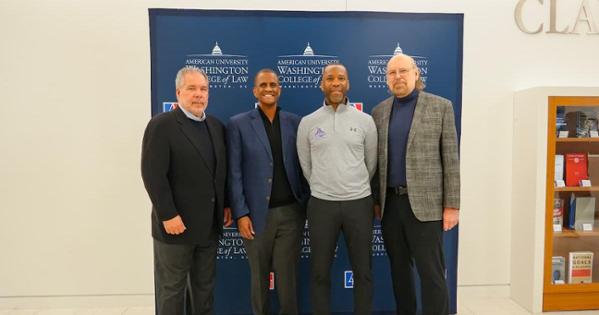Making Baskets—and History

Decades later, it’s hard to know what David Carrasco Sr. was thinking as he stood over the swimming pool watching his AU men’s basketball players celebrate a huge Mason-Dixon Conference victory on the road against Randolph-Macon College.
But one thing is certain: After a hotly contested game the Eagles won in an unwelcoming environment, the Ashland, Virginia, school’s athletic director was not happy to discover Black, White, and Jewish Eagles players splashing around together in the segregated South.
“What are going to do about this?” the athletic director yelled at Carrasco, AU’s athletic director and head coach.
“What do you want me to do?” Carrasco asked.
“You’ve got to get these guys out of here.”
“Don’t worry, we’ll get out, just as soon as I do this,” Carrasco said before jumping into pool with his players, clothes and all.
Ed Tapscott, WCL/JD ’80, retold the story of defiance he’d heard secondhand from Wil Jones, CAS/BA ’64, one of the Black players on the team, during an event at WCL’s Claudio Grossman Hall on February 3. The little-known details of how AU integrated DC college basketball in 1956—nearly a decade before any other school in the Washington—were the subject of a Black History Month panel discussion cosponsored by AU Athletics, WCL’s Sport and Society Initiative, and the Kogod School of Business.  “This gave me a sense of the color of the moment and the special team bonds that were forged with this group,” said Tapscott, who became AU’s first Black head coach in 1982. “I’m delighted we are telling this story today. This is an important story to this institution. This is an important story of the District of Columbia.”
“This gave me a sense of the color of the moment and the special team bonds that were forged with this group,” said Tapscott, who became AU’s first Black head coach in 1982. “I’m delighted we are telling this story today. This is an important story to this institution. This is an important story of the District of Columbia.”
David Aldridge, SOC/BA ’87, senior columnist for the Athletic and former NBA sideline reporter, moderated the conversation with David Carrasco Jr., a Harvard University professor and son of the late head coach; AU men’s basketball head coach Duane Simpkins; and Tapscott, a longtime NBA executive and DC native.
“I’m amazed, Mr. Carrasco, that this hasn’t been made into a movie several times,” Aldridge said. “I am floored by your father’s life.”
In 1956, Carrasco, the first Mexican American to be named a head coach for a major US men’s basketball program, hadn’t been on the job long when he told then AU president Hurst Anderson that he wanted to integrate its basketball team. Anderson agreed.
“This is seven years before the March on Washington,” Simpkins said. “This is eight years before the Civil Rights Act was passed. What your dad did, I don’t know that I would have had the courage to do that,” he said to Carrasco Jr.
Soon after, Carrasco recruited local player Dickie Wells, CAS/BA ’65, who officially broke the color barrier in the DC area when he started at center in AU’s season opener at the Naval Academy on December 5, 1956. Jones joined the team later that season.
Those teams were not only pioneers, but winners too. After Carrasco’s first Eagles squad went 10–14 in the 1956–57 season, the program won 66 games, three Mason-Dixon Conference titles, and made three trips to the NCAA College Division tournament between 1957 and 1959. For his part, Carrasco was named the 1958 college-division national coach of the year.
Carrasco Jr. said social justice was a big part of who his father was away from the game. Carrasco Sr. grew up in the El Segundo Barrio, a dangerous neighborhood located near the border in El Paso, Texas. There, the 6-foot-4, 220-pound Carrasco was a street fighter and talented basketball player in his own right before enlisting in the Navy.
After he was commissioned, Carrasco moved to Naval Training Center Bainbridge in Maryland to train African American midshipmen. As a person of color himself, that experience helped inform how he connected with the families of his Black players, convincing the would-be recruits he would be there to take care of them. The rest is history.
“They saw that this man shared their world,” Carrasco Jr. said. “It’s really important to understand that’s what you needed at that time, for this to take place at AU.”
Learn more about DC’s first integrated basketball team on the AU Athletics website.
